Design Philosophy 3

The Bridge and Bridge Plate

The Edwinson Talon bridge is an asymmetrical, two stage, pinned bridge design, and is probably the single most distinguishing visual feature of an Edwinson guitar. I sure do get a lot of comments on it. It’s been called the “batman bridge” and has also garnered comparisons to Ninja weaponry. Stylistically, this bridge may not be everyones’ cup of tea--traditionalists may balk--but most people I’ve heard from express admiration for the edgy verve of the Talon. Either way, it’s become my most identifiable trademark, and I’m sticking with it.
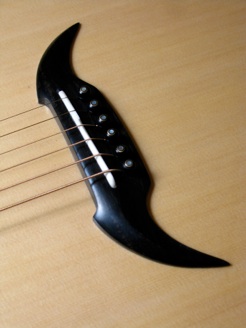
In order for the bridge to drive the soundboard efficiently, the strings need to exert the right amount of down pressure on the saddle. On the Talon, the break angle of the strings over the saddle to the bridge pins is set at an optimal fifteen degrees. There’s plenty of down force here, which transmits vibrating string energy directly to the soundboard with very little dissipation.
The bottom, or footprint of the bridge, is radiused concavely to match the dome of the top, so there’s no one component forcing another. Perfect compliance between the bridge and soundboard is essential.
The carve of the Talon bridge makes it very rigid and strong. The bridge is carved from tip to tip to have minimal cross-dipole flexion. It works like a sculpted I-Beam. The bridge itself is acting as a primary top brace, structurally coupled with everything underneath. The rigid structure of this bridge limits the cross-dipole “wobble” of the soundboard, theoretically giving the guitar a more focused and balanced sound. The bridge is not just along for the ride. The bridge is the ride, the engine that makes the top GO.
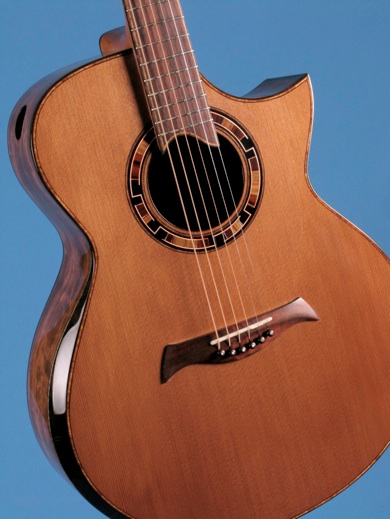
My design criteria were mainly that the new bridge had to have the same functional aspects as the Talon; that is, a two-stage carve, a fifteen degree string break angle, and cross-dipole rigidity. It must also look modern, but a little less dangerous than the Talon, while still having a recognizable Edwinson aesthetic. The new bridge design, used first on Ernie’s guitar, is called the “Element” style bridge. At left is Ernie’s guitar.
The Element bridge has since undergone some tweaks, and I’m now up to version 3.0, as seen below. About half of my custom guitar orders now specify the Element style bridge, so I’m very glad that Ernie spurred me on and got me to come up with this new bridge design.
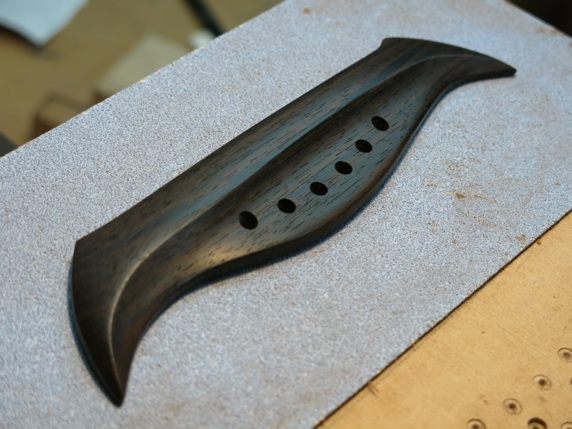
For multiscale (fanned-fret) guitars, I am making both the Talon style and the Element style bridges. Below, a couple of examples.
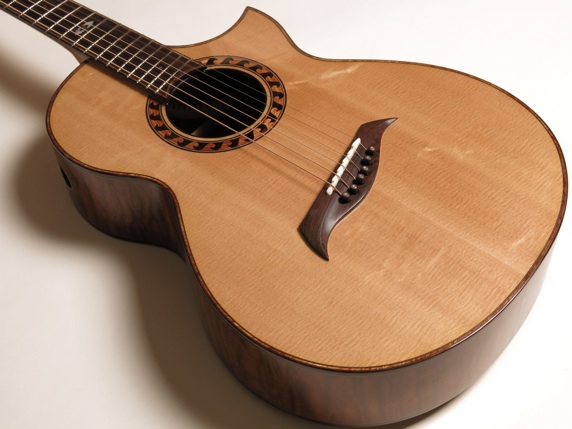
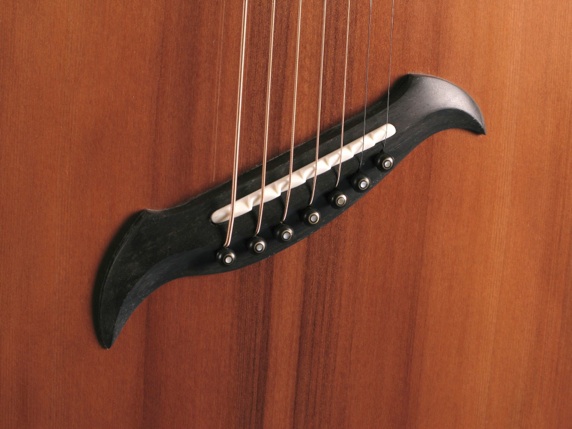
The standard saddle width on a uni-scale bridge is 1/8”.
About the Bridge Plate...
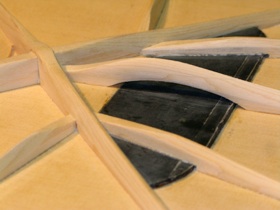
The bridge plate resides on the underside of the soundboard, directly beneath the bridge. Its function is to provide a stable internal footing for the bridge, and it also serves as a platform for anchoring the ball-ends of the strings. The bridge plate is a very important part of the guitar top, as it has a great deal of influence on both the structural integrity of the soundboard, and also on the quality of tone production.
Traditionally, the bridge plate is a Maple or Rosewood piece, transecting the lower bout legs of the X brace. In most production guitars, the plate is 1/8” to 3/16” thick. It always seemed to me that putting that much mass in such an acoustically active part of the top might have some significant damping effect; but it is necessary, mostly to keep the ball ends of the strings from chewing their way through the soundboard after years of string changes, and to keep the forward torque of the bridge under control. Even so, many well-used old guitars will eventually need to have some expensive and difficult work done to restore the function of a badly eroded, warped, or detached bridge plate.
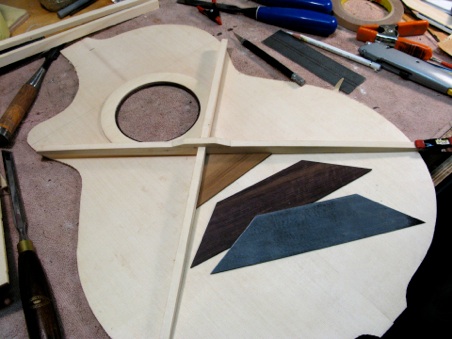
The rosewood and the carbon fiber are both acoustically lively materials, so there is minimal damping. And, this construction has the added benefit that the ball ends of the strings will never chew up the carbon fiber plate that they are anchored against. This is a repair that will never be needed on an Edwinson guitar.
As you can see in the photo above, I also glue a triangular, cross-grain patch of spruce or cedar in the crotch of the X brace. This prevents a dimple from forming in the top, as often seen in conventionally braced guitars. It also helps tie together the whole system of the bridge plate and braces.
The design and engineering of the acoustic guitar bridge, and its underlying architecture, are hugely important factors in the quality of tone production, and also for the long-term physical stability of the instrument. The bridge’s job is to securely anchor somewhere between 150 and 190 pounds of constant string pull, and also to transmit the energy of those vibrating strings into the guitar sound box. That’s a lot of responsibility to place on one small piece of wood, especially on such a delicately built structure as an acoustic guitar.

